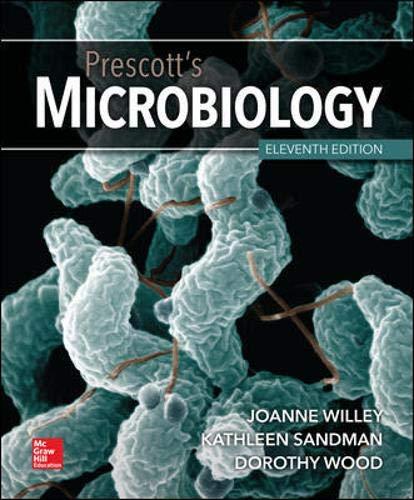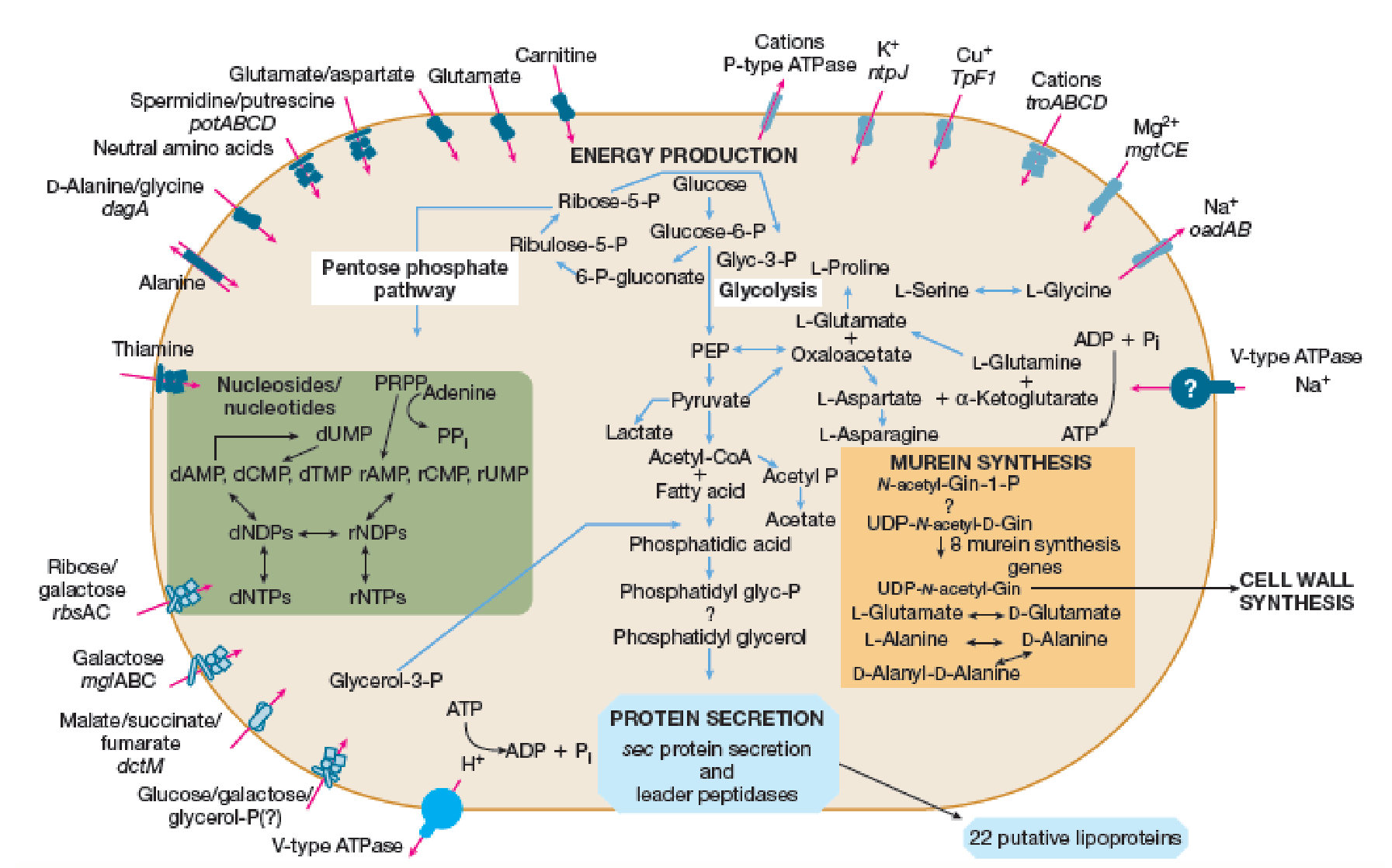
Prescott's Microbiology
11th Edition
ISBN: 9781260211887
Author: WILLEY, Sandman, Wood
Publisher: McGraw Hill
expand_more
expand_more
format_list_bulleted
Textbook Question
Chapter 18.5, Problem 1MI

Figure 18.12 Metabolic Pathways and Transport Systems of Treponema pallidum. This depicts T. pallidum
Based on this genomic reconstruction, can you determine if T. pallidum has a respiratory or fermentative metabolism?
Expert Solution & Answer
Trending nowThis is a popular solution!

Students have asked these similar questions
a. What is the function of bactoprenol in peptidoglycan synthesis?
b. During peptidoglycan synthesis, removal of a phosphate group from bactoprenol pyrophosphate is
inhibited. What is the immediate outcome? What does this mean for cell wall synthesis? Which
antibiotic works via this mechanism?
c. Bacterium Y is photosynthetic. You want to decrease the ability of Bacterium Y to produce glucose
through photosynthesis. Explain how you could manipulate the light reactions of photosynthesis to
decrease glucose production during the dark reactions in Bacterium Y. Include the name of the
pathway that makes glucose during the dark reactions, which/how molecules from the light
reactions are used in this pathway, and what specific steps of this pathway would be affected by
your manipulations.
Why are there reversible steps in the glycolytic pathway? Explain why they all be could not be irreversible?
Peroxidase is an enzyme found in many organisms, from plant to humans. The function of peroxidase is to break down hydrogen peroxide, which is a toxin produced as a byproduct when oxygen is
produced during respiration. Myeloperoxidase is a protein found in neutrophils and catalyzes lipid peroxidation involved in immune defense. The overproduction of myeloperoxidase has been found to
function as a mediator for tissue damage in inflammatory diseases. (8 points)
a. Identify two examples of environmental factors that may impact myeloperoxidase activity. Describe how each of the environmental factors would affect the reaction rate of the enzyme.
b. Predict the how researchers can use myeloperoxidase activity as oxidative stress biomarkers in patients with rheumatoid arthritis. Provide reasoning to justify your prediction.
Chapter 18 Solutions
Prescott's Microbiology
Ch. 18.1 - MICRO INQUIRY What is the function of the 3-OH...Ch. 18.1 - MICRO INQUIRY Why is it important that identical...Ch. 18.2 - MICRO INQUIRY Which step (or steps) in this...Ch. 18.2 - Retrieve, Infer, Apply Why is the Sanger technique...Ch. 18.2 - Retrieve, Infer, Apply Explain the difference...Ch. 18.2 - Retrieve, Infer, Apply Why does reversible chain...Ch. 18.2 - Prob. 4CCCh. 18.2 - Retrieve, Infer, Apply Suggest a medical and an...Ch. 18.3 - Retrieve, Infer, Apply NGS techniques are...Ch. 18.3 - Retrieve, Infer, Apply Examine figure 18.8. How...
Ch. 18.4 - Prob. 1MICh. 18.4 - Prob. 1CCCh. 18.4 - Prob. 2CCCh. 18.4 - Prob. 3CCCh. 18.5 - Figure 18.12 Metabolic Pathways and Transport...Ch. 18.5 - Prob. 2MICh. 18.5 - Prob. 3MICh. 18.5 - Prob. 1CCCh. 18.5 - Retrieve, Infer, Apply How might the following...Ch. 18.5 - Retrieve, Infer, Apply Compare and contrast...Ch. 18.5 - Retrieve, Infer, Apply Why does two-dimensional...Ch. 18.5 - Retrieve, Infer, Apply What is the difference...Ch. 18.5 - Retrieve, Infer, Apply Describe a ChIP-Seq...Ch. 18.7 - Prob. 1MICh. 18.7 - Retrieve, Infer, Apply Cite an infectious disease...Ch. 18.7 - Prob. 2CCCh. 18.7 - Prob. 3CCCh. 18 - Prob. 1RCCh. 18 - Prob. 2RCCh. 18 - Prob. 3RCCh. 18 - Prob. 4RCCh. 18 - Prob. 5RCCh. 18 - Prob. 1ALCh. 18 - Prob. 2ALCh. 18 - You are developing a new vaccine for a pathogen....Ch. 18 - Prob. 4AL
Knowledge Booster
Learn more about
Need a deep-dive on the concept behind this application? Look no further. Learn more about this topic, biology and related others by exploring similar questions and additional content below.Similar questions
- The pathway for cystiene synthesis in E.coli involves five precursor compounds, compound A-E. The requirements for each of the autotrophs are summarized in the table below. Use the data, define the biosynthetic pathway. Draw the pathway for cysteine synthesis. Fill in the blanks with A-E compounds as appropriate and then label the arrows with the auxotrophs C1-C8 that are unable to complete that step. There are may be more than one quxotroph that is defective at a particular step. that is - on C4 in Darrow_forwardPompe disease is due to a deficiency in lysosomal α-1,4-glucosidase, also called acid maltase. Lysosomes function as recycling centers in the cell and normally degrade excess muscle glycogen into glucose for the energy-converting reactions of the glycolytic pathway. Pompe disease was described in 1932 by Dutch pathologist Johann Pompe, who recognized that lysosomes in the affected patient's accumulated large amounts of glycogen. However, Henri Hers—the same Belgian pathologist who described the symptoms of liver glycogen phosphorylase deficiency (Hers disease)—discovered in 1965 that Pompe disease was due to a lysosomal α-1,4-glucosidase deficiency. Enzyme deficiency Disease name Organ Disease symptoms Lysosomal α-1,4- glucosidase Pompe All organs Heart failure in infantile form; muscle defects in juvenile form Answer these questions: What protein/enzyme does the mutation effects? Symptoms and, if you can, how are the symptoms…arrow_forwardYarrowia lipolytica(Yl) is a non-conventional yeast that diverged from baker’s yeast, Saccharomyces cerevisiae(Sc), early in evolutionary history. The regulation of glycolytic enzymes in Yl differs from that of Sc. The data below pertain to regulation of phosphofructokinase 1 (PFK). Data for Yl is shown with black circles and data for Sc is shown with white circles. Pfk for both species is a homo-octomer (eight identical subunits). Given the data below, which species is more likely to be susceptible to allosteric modification? Briefly explain.arrow_forward
- Yarrowia lipolytica(Yl) is a non-conventional yeast that diverged from baker’s yeast, Saccharomyces cerevisiae(Sc), early in evolutionary history. The regulation of glycolytic enzymes in Yl differs from that of Sc. The data below pertain to regulation of phosphofructokinase 1 (PFK). Data for Yl is shown with black circles and data for Sc is shown with white circles. Imagine that the genes for phosphofructose kinase 2 and fructose 2,6-bisphosphatase were deleted in each species. Which species would you expect to have greater metabolic disruption and why?arrow_forwardLeigh syndrome is characterized by psychomotor regression: that is, the progressive loss of mental andmovement abilities. Patients also suffer from lacticacidosis, a condition in which mitochondrial respiration is deficient, so their tissues metabolize glucoseanaerobically, leading to the buildup of lactate. Somepatients with Leigh syndrome have a mutation in themitochondrial gene MT-CO3, which encodes a subunit of the electron transport complex cytochromec oxidase. Other patients diagnosed with Leigh syndrome have a loss-of-function mutation in the nucleargene SURF1, which encodes a factor needed for theassembly of this same enzyme complex.a. How can the same symptoms result from mutationsin a mitochondrial gene and from mutations in anuclear gene?arrow_forwardThe pathway shown below is used by a fungus to create Fructose-1,6-diphosphate from glucose. A silent mutation occurs in the gene that encodes enzyme 3. This fungus is grown on media that only contains the precursor. Discuss the effects of this mutation on: (i) The function of Enzyme 3 (ií) The production of Fructose-1,6-diphosphate Enzyme 1 Glucose-6- Enzyme 2 fructose-6- Enzyme 3 Fructose-1,6- Glucose phosphate phosphate diphosphatearrow_forward
- Complex II contains one heme b moiety that is not in the direct path of electron transfer (despite what many figures found on the internet show). It may serve instead to decrease the frequency with which electrons leak out of the system to produce reactive oxidative species (ROS). Discuss the correlation between a defective heme b in Complex II and the development of certain types of cancer. Name some of the ROS and give their structures. How are ROS generated? What are some of the mechanisms by which the oxidative stress caused by ROS is alleviated? What are some of the damaging effects of ROS? How might these damaging effects lead to cancer?arrow_forwardReferring to figure 5 and 8 which substrate molecule serves as the phosphate donor during substrate-level phosphorylation in step 10 of glycosis and the succinyl CoA-succinate step of the Krebs Cycle?arrow_forwardGive typing answer with explanation and conclusion to all parts The pharmaceutical (−)-trans-Δ9-tetrahydrocannabinol (THC) is a metabolite that is biosynthesized specifically the glandular trichome cells of the plant species Cannabis sativa. The gene that catalyzes that last step in THC biosynthesis, namely THC ACID SYNTHASE (THCAS), is expressed exclusively in the glandular trichome cells of the plant and no other cell types. Given that all cell types arise from stem cells that have identical DNA, explain how glandular trichome cells develop unique morphology and why THCAS is expressed exclusively in that cell type.arrow_forward
- Multivitamin B complex are essential compounds that are used as derivatives for compounds necessary for many metabolic activities. Give 3 vitamin B compounds and explain where and how they are used along the metabolic pathway.arrow_forwardIdentify the substrate and products of the TCA cycle. Describe its organization in general terms. What are its major functions?arrow_forwardPlease briefly explain the ATP_modulated actomyosin cycle.arrow_forward
arrow_back_ios
SEE MORE QUESTIONS
arrow_forward_ios
Recommended textbooks for you

Parasites: Protozoa (classification, structure, life cycle); Author: ATP;https://www.youtube.com/watch?v=V4iSB0_7opM;License: Standard youtube license